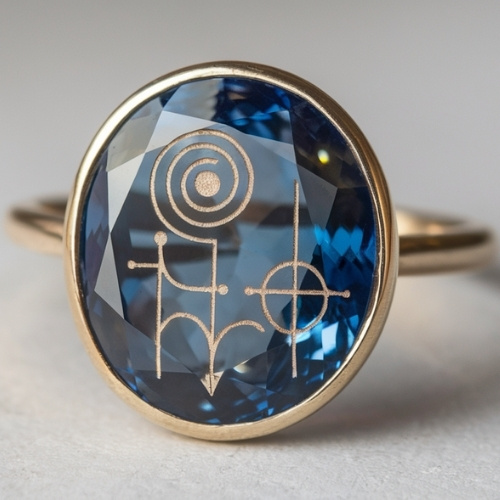Estimated reading time: 6 minutes
Sapphires have captivated jewellers and gemstone lovers for centuries. As such, these stunning gems appear in myths and legends that span cultures and time.
Sapphires have long been symbols of wisdom, power, and divine connection. Whether you’re intrigued by their history, their beauty, or their meanings, the tales behind these gems are endlessly fascinating.
🔗These ancient stories often influence how we view sapphire today, from spiritual qualities to symbolic associations. Discover The Symbolic & Spiritual Meanings of Sapphire
Jump to:
The Persian Sapphire Sky
Ancient Persians had a wonderfully poetic idea about why the sky is such a brilliant blue. They believed the Earth rested upon a massive sapphire, and the sky’s colour was simply its reflection. Isn’t that a beautiful image?
To the Persians, sapphire gemstones were a link between the earth and the heavens, a reminder of nature’s grandeur. Holding or gazing upon a sapphire was almost like peeking at the very foundation of the world, a belief that made these gems feel truly sacred.
King Solomon’s Sapphire Seal
King Solomon is one of those legendary figures whose name most people have heard. He was the son of King David and Bathsheba, and ruled Israel around the 10th century BCE during what’s remembered as a golden age of peace and prosperity. Solomon was famous for his incredible wisdom, the kind that made people travel from far and wide just to hear him speak.
One of the most famous stories tells how Solomon solved an impossible dispute between two women who both claimed to be a child’s mother. You might have heard it. It’s the one where he suggested cutting the baby in half so each woman could have a piece. The true mother, horrified at the thought, immediately begged the king to give the child to the other woman instead. In that moment, Solomon knew she was the real mother. His clever and compassionate judgment revealed the truth, and ever since, “the wisdom of Solomon” has been a phrase in its own right.
But for all his brilliance, Solomon was still human. As the years went by, he began to drift from the spiritual path that had once guided him. Wealth, power, and countless political marriages slowly turned his heart away from the divine wisdom he was known for. Many versions of the story say that this was his great downfall. That even the wisest of kings can lose sight of where their light truly comes from. When he strayed, so too did the harmony of his kingdom, which eventually fell into unrest after his death.
The kings ring
Among the many tales about Solomon, one shines brighter than most, the story of his ring, the legendary Seal of Solomon. This was said to be no ordinary piece of jewellery. The ring was a divine gift, a symbol of the connection between Solomon and the heavens. In Jewish and Islamic traditions, it granted him the power to command spirits and djinn, speak to animals, and see truth from lies. The ring was said to bear a sacred inscription and glimmered with a light of its own.
In later medieval retellings, a sapphire was said to be set into the ring, representing clarity, wisdom, and divine truth. Its rich blue mirrored the sky, reminding Solomon that his power came not from earthly strength, but from the heavens above. Yet when his pride grew too great and he forgot the source of his gift, the ring was lost. Some stories claim it was stolen by a demon, others that it was swallowed by the sea. It was as if the sapphire refused to shine for a king who had lost his way.
The ring’s fate remains one of history’s great mysteries. Some say it still lies hidden somewhere, waiting for a soul wise and pure enough to claim it once more.
The Stone of Heaven
During the Middle Ages, some believed that sapphires were fragments of the Throne of Heaven, scattered across the Earth when it fell from the skies. While the story’s origins are a bit mysterious, the idea itself is enchanting: these gems as tiny pieces of the divine, carrying wisdom, purity, and protection.
But what was the Throne of Heaven? In medieval Christian thought, the Throne was seen as the seat of God. A radiant, celestial throne described in biblical visions like those of Ezekiel and Revelation. It was said to blaze with light and colour, surrounded by choirs of angels and the shifting hues of precious stones. The sapphire, in particular, was believed to form part of its foundation or flooring. A gleaming blue expanse representing divine truth and heavenly order.
As the legend evolved, some storytellers imagined that when humanity fell into sin or when divine order was disrupted, the Throne trembled and fragments of its sapphire base tumbled to Earth. These fallen shards, still glowing with celestial energy, became the sapphires found in the mortal realm. Gifts of the heavens meant to remind humankind of their spiritual origins and the pursuit of purity.
Clergy and royalty treasured sapphires, often adorning rings and religious relics with them. They were thought to bring spiritual insight and shield the wearer from harm, further cementing sapphires’ connection to the sacred. Whether as a piece of the celestial realm or a conduit to higher understanding, these gems radiated an almost magical aura.
The Magic of Sapphire
These legends remind us that sapphires are far more than beautiful gemstones, they’re glimpses into history. Symbols of wonder, and endless sources of inspiration for jewellers and collectors alike. From Persian temples to ancient royal courts, sapphires have enchanted humanity for millennia.
Whether you see them as gifts from the gods, symbols of wisdom, or guardians of fate, sapphires continue to carry a sense of mystery and magic. And perhaps the next sapphire you hold has its own untold story, just waiting to be discovered.
Just a quick side note – these sapphire myths and legends make great marketing content, so feel free to retell them to your audience!
🔗 Want some guidance on using gemstone knowledge to market your jewellery business? Read Using Gemstone Knowledge to Boost Your Jewellery Sales
🔗 Working with sapphires in your jewellery making? Take a look at my Jeweller’s Guide to Sapphire
🛍️ Curious to find a pre-owned sapphire for your next design? Check out what’s available.
📌 Save this blog post about sapphire mythology so you can easily find it again.




